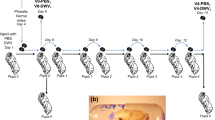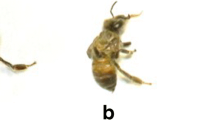Abstract
The small hive beetle (SHB, Aethina tumida) is a parasite and scavenger of honeybee colonies. Here, we conducted laboratory experiments to investigate the potential of SHB as a vector of honeybee viruses. Using RT-PCR methods, Deformed Wing Virus (DWV) was detected in adult SHBs that: (1) were fed with dead workers with deformed wings, (2) were fed with DWV-positive brood, and (3) were associated with DWV-contaminated wax. SHB became significantly more often infected through feeding on virus infected workers, brood and the virus contaminated wax compared to pollen and the controls, where no infections were found. DWV was also detected in adult SHB after trophallaxis with infected workers. Further, among SHBs identified as DWV-positive, 40% of beetles carried negative stranded RNA of DWV, indicating virus replication. Our results suggest that SHB can be infected with honeybee viruses via food-borne transmission and have the potential of being a biological vector of honeybee viruses.
Zusammenfassung
Der Kleine Beutenkäfer, Aethina tumida (Coleoptera: Nitidulidae), ist ein Parasit von Völkern der Honigbiene, Apis mellifera, der sich als invasive Art rasch ausbreitet. Die Käfer paaren und vermehren sich innerhalb des Bienenstocks und können somit über verschiedene Kontaminierungswege mit Viren der Honigbiene infiziert werden. Wir präsentieren hier, mit Hilfe von RT-PCR Methoden, den ersten Nachweis von Honigbienenviren im Kleinen Beutenkäfer und in Bienenwachs. Der Kleine Beutenkäfer wurde in Käfigexperimenten mit dem Flügeldeformations-Virus (DWV) infiziert über: (1) Fütterung mit toten Arbeiterinnen mit klinischen Symptomen (deformierte Flügel), (2) Fütterung mit DWV positiver Bienenbrut, (3) Assoziation mit DWV kontaminiertem Wachs und (4) Trophallaxis mit infizierten Arbeiterinnen (Abb. 1). Wir fanden jedoch keinen Hinweis für eine orale Infektion über DWV kontaminierten Pollen (Abb. 1). In 40 % der DWV positiven Käferproben konnte der minus RNA Strang des DWV nachgewiesen werden (Abb. 2), was ein Hinweis dafür ist, dass sich das +RNA Virus im Käfer vermehren kann. Unsere Ergebnisse zeigen zum ersten Mal, dass eine orale Infektion mit Honigbienenviren über Wachs möglich ist. Darüber hinaus ist der Kleine Beutenkäfer ein potentieller biologischer Vektor von Honigbienenviren, was für deren Verbreitung innerhalb und zwischen Völkern relevant sein kann.
Similar content being viewed by others
References
Anderson D.L. (1991) Kashmir bee virus-a relatively harmless virus of honey bee colonies, Am. Bee J. 131, 767–770.
Allen M., Ball B.V. (1996) The incidence and world distribution of honeybee viruses, Bee World 77, 141–162.
Bailey L. (1969) The multiplication and spread of sac brood virus of bees, Ann. Appl. Biol. 63, 483–491.
Bailey L. (1976) Viruses attacking the honey bee, Adv. Virus Res. 20, 271–304.
Bailey L., Ball B.V. (1991) Honey bee pathology, 2nd ed., Academic Press, London, United Kingdom.
Bakonyi T., Farkas R., Szendroi A., Dobos-Kovacs M., Rusvai M. (2002) Detection of acute bee paralysis virus by RT-PCR in honey bee and Varroa destructor field samples: rapid screening of representative Hungarian apiaries, Apidologie 33, 63–74.
Bowen-Walker P.L., Martin S.J., Gunn A. (1999) The transmission of deformed wing virus between honeybees (Apis mellifera L.) by the ectoparasitic mite Varroa jacobsoni Oud, J. Invertebr. Pathol. 73, 101–106.
Buchholz S., Schäfer M.O., Spiewok S., Pettis J.S., Duncan M., Ritter W., Spooner-Hart R., Neumann P. (2008) Alternative food sources of Aethina tumida (Coleoptera: Nitidulidae), J. Apic. Res. 47, 201–208.
Celle O., Blanchard P., Olivier V., Schurr F., Cougoule N., Faucon J.-P., Ribière M. (2008) Detection of Chronic bee paralysis virus (CBPV) genome and its replicative RNA form in various hosts and possible ways of spread, Virus Res. 133, 280–284.
Chen Y.P., Siede R. (2007) Honeybee viruses, Adv. Virus Res. 70, 33–80.
Chen Y.P., Higgins J.A., Feldlaufer M.F. (2005) Quantitative Real-Time Reverse TranscriptionPCR Analysis of Deformed Wing Virus Infection in the Honeybee (Apis mellifera L.), Appl. Environ. Microbiol. 71, 436–441.
Chen Y.P., Evans J.D., Feldlaufer M.F. (2006a) Horizontal and vertical transmission of viruses in the honey bee, Apis mellifera, J. Invertebr. Pathol. 92, 152–159.
Chen Y.P., Pettis J.S., Collins A., Feldlaufer M.F. (2006b) Prevalence and transmission of honey bee viruses, Appl. Environ. Microbiol. 72, 606–611.
Cox-Foster D.L., Conlan S., Holmes E.C., Palacios G., Evans J.D., Moran N.A., Quan P.-L., Briese T., Hornig M., Geiser D.M., Martinson V., van Engelsdorp D., Kalkstein A.L., Drysdale A., Hui J., Zhai J., Cui L., Hutchison S.K., Simons J.F., Egholm M., Pettis J.S., Lipkin W.I. (2007) A Metagenomic Survey of Microbes in Honey Bee Colony Collapse Disorder, Science 318, 283–287.
Dainat B., Ken T., Berthoud H., Neumann P. (2008) The ectoparasitic mite Tropilaelaps mercedesae (Acari: Laelapidae) as a vector of honeybee viruses, Insectes Soc., DOI 10.1007/s00040-008-1030-5.
Domingo E., Holland J.J. (1997) RNA virus mutations and fitness for survival, Annu. Rev. Microbiol. 51, 151–178.
Domingo E., Baranowski E., Ruiz-Jarabo C.M., Martín-Hernández A.M., Sáiz J.C., Escarmís C. (1998) Quasispecies Structure and Persistence of RNA Viruses, Emerg. Infect. Dis. 4, 521–527.
Ellis J.D., Neumann P., Hepburn H.R., Elzen P.J. (2002a) Longevity and reproductive success of Aethina tumida (Coleoptera: Nitidulidae) fed different natural diets, J. Econ. Entomol. 95, 902–907.
Ellis J.D., Pirk C.W.W., Hepburn H.R., Kastberger G., Elzen P.J. (2002b) Small hive beetles survive in honeybee prisons by behavioural mimicry, Naturwissenschaften 89, 326–328.
Elzen P.J., Baxter J.R., Westervelt D., Randall C., Wilson W.T. (2000) A scientific note on observations of the small hive beetle, Aethina tumida Murray (Coleoptera, Nitidulidae), in Florida, USA, Apidologie 31, 593–594.
Elzen P.J., Baxter J.R., Neumann P., Solbrig A.J., Pirk C.W.W., Hepburn H.R., Westervelt D., Randall C. (2001) Behavior of African and European subspecies of Apis mellifera toward the small hive beetle, Aethina tumida, J. Apic. Res. 40, 40–41.
Genbank database at the National Center for Biotechnology, NC_004830 and AY292384 [online] http://www.ncbi.nlm.nih.gov (accessed on 15 September 2008).
Genersch E., Yue C., Fries I., de Miranda J.R. (2006) Detection of deformed wing virus, a honey bee viral pathogen, in bumble bee (Bombus terrestris and Bombus pascuorum) with wing deformities, J. Invertebr. Pathol. 91, 61–63.
Hoffmann D., Pettis J.S., Neumann P. (2008) Potential host shift of the small hive beetle (Aethina tumida) to bumblebee colonies (Bombus impatiens), Insectes Soc. 55, 153–162.
Holland J., Spindler K., Horodyski F., Grabau E., Nichol S., Vandepol S. (1982) Rapid evolution of RNA genomes, Science 215, 1577–1585.
Lanzi G., de Miranda J.R., Boniotti M.B., Cameron C.E., Lavazza A., Capucci L., Camazine S.M., Rossi C. (2006) Molecular and biological characterization of deformed wing virus of honey bees (Apis mellifera), J. Virol. 80, 4998–5009.
Lundie A.E. (1940) The small hive beetle Aethina tumida, Science Bulletin 220, Dep. Agr. Forestry, Government Printer, Pretoria, South Africa.
Martin S.J. (2001) The role of Va r r o a and viral pathogens in the collapse of honeybee colonies: a modeling approach, J. Appl. Ecol. 38, 1082–1093.
Morse R.A. (1972) The complete guide to beekeeping, E. P. & Co. Dutton, New York
Mürrle T.M., Neumann P. (2004) Mass production of small hive beetles (Aethina tumida Murray, Coleoptera: Nitidulidae), J. Apic. Res. 43, 144–145.
Neumann P., Elzen P.J. (2004) The biology of the small hive beetle (Aethina tumida, Coleoptera: Nitidulidae): gaps in our knowledge of an invasive species, Apidologie 35, 229–247.
Neumann P., Ellis J.D. (2008) The small hive beetle (Aethina tumida Murray, Coleoptera: Nitidulidae): distribution, biology and control of an invasive species, J. Apic. Res. 47, 180–183.
Neumann P., Pirk C.W.W., Hepburn H.R., Solbrig A.J., Ratnieks F.L.W., Elzen P.J., Baxter J.R. (2001a) Social encapsulation of beetle parasites by Cape honeybee colonies (Apis mellifera capensis Esch.), Naturwissenschaften 88, 214–216.
Neumann P., Pirk C.W.W., Hepburn H.R., Elzen P.J., Baxter J.R. (2001b) Laboratory rearing of small hive beetles (Aethina tumida), J. Apic. Res. 40, 111–112.
Ongus J.R., Peters D., Bonmatin J.-M., Bengsch E., Vlak J.M., Van Oers M.M. (2004) Complete sequence of a picorna-like virus of the genus Iflavirus replicating in the mite Varroa destructor, J. Gen. Virol. 85, 3747–3755.
Ribière M., Lallemand P., Iscache A.L., Schurr F., Celle O., Blanchard P., Olivier V., Faucon J.P. (2007) Spread of infectious Chronic bee paralysis virus by honeybee (Apis mellifera L.) faeces, Appl. Environ. Microbiol. 73, 7711–7716.
Schäfer M.O., Pettis J.S., Ritter W., Neumann P. (2008) A scientific note on quantitative diagnosis of small hive beetles, Aethina tumida, in the field, Apidologie 39, 564–565.
Shen M.Q., Cui L.W., Ostiguy N., Cox-Foster D. (2005) Intricate transmission routes and interactions between picorna-like viruses (Kashmir bee virus and Sacbrood virus) with the honeybee host and the parasitic varroa mite, J. Gen. Virol. 86, 2281–2289.
Spiewok S., Pettis J.S., Duncan M., Spooner-Hart R., Westervelt D., Neumann P. (2007) Small hive beetle, Aethina tumida, populations I: Infestation levels of honeybee colonies, apiaries and regions, Apidologie 38, 595–605.
Spiewok S., Duncan M., Spooner-Hart R., Pettis J.S., Neumann P. (2008) Small hive beetle, Aethina tumida, populations II: Dispersal of small hive beetles, Apidologie 39, 683–693.
Schmolke M.D. (1974) A study of Aethina tumida: the small hive beetle, Project Report, University of Rhodesia.
Tentcheva D., Gauthier L., Jouve S., Canabady-Rochelle L., Dainat B., Cousserans F., Colin M.E., Ball B.V., Bergoin M. (2004a) Polymerase Chain Reaction detection of deformed wing virus (DWV) in Apis mellifera and Varroa destructor, Apidologie 35, 431–439.
Tentcheva D., Gauthier L., Zappulla N., Dainat B., Cousserans F., Colin M.E., Bergoin M. (2004b) Prevalence and seasonal variations of six bee viruses in Apis mellifera L. and Varroa destructor mite populations in France, Appl. Environ. Microbiol. 70, 7185–7191.
Tentcheva D., Gauthier L., Bagny L., Fievet J., Dainat B., Cousserans F., Colin M.E., Bergoin M. (2006) Comparative analysis of deformed wing virus (DWV) RNA in Apis mellifera and Varroa destructor, Apidologie 37, 41–50.
Voinnet O. (2001) RNA silencing as a plant immune system against viruses, Trends Genet. 17, 449–459.
Vignuzzi M., Stone J.K., Arnold J.J., Cameron C.E., Andino R. (2006) Quasispecies diversity determines pathogenesis through cooperative interactions within a viral population, Nature 439, 344–348.
Yen Y., Green P.J. (1991) Identification and properties of the major ribonucleases of Arabidopsis thaliana, Plant Physiol. 97, 1487–1493.
Yue C., Genersch E. (2005) RT-PCR analysis of Deformed wing virus in honeybees (Apis mellifera) and mites (Varroa destructor), J. Gen. Virol. 86, 3419–3424.
Woolhouse M.E.J., Taylor L.H., Haydon D.T. (2001) Population biology of multihost pathogens, Science 292 (5519), 1109–1112.
Author information
Authors and Affiliations
Corresponding author
Additional information
Manuscript editor: David Tarpy
Rights and permissions
About this article
Cite this article
Eyer, M., Chen, Y.P., Schäfer, M.O. et al. Small hive beetle, Aethina tumida, as a potential biological vector of honeybee viruses. Apidologie 40, 419–428 (2009). https://doi.org/10.1051/apido:2008051
Received:
Revised:
Accepted:
Issue Date:
DOI: https://doi.org/10.1051/apido:2008051




